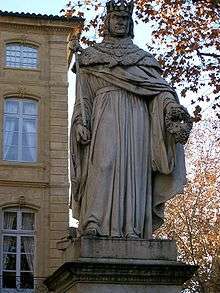La cheminée du roi René

La cheminée du roi René[1] (The Fireplace of King René), Op. 205, is a suite in seven movements for wind quintet, composed in 1939 by the French composer Darius Milhaud.
Genesis
The suite is an adaptation of the music that the composer wrote for Raymond Bernard's 1939 film Cavalcade d'amour. It was first performed in 1941 at Mills College, California. The screenplay by Jean Anouilh and Jean Aurenche is set in the court of René I in the fifteenth century and includes three love stories with incidental music by the composers Milhaud, Honegger and Désormière.
The castle and the court of René I, count of Provence, were situated in Aix-en-Provence, birthplace of Darius Milhaud who was always fascinated by the history of the king, his code of chivalry and the legendary tournaments that took place at his court. Although the composer studied several musical manuscripts of the period, the writing of the La cheminée du roi René shows very little evidence of this and the piece bears the characteristic hallmarks of the rest of Milhaud's music.
Structure
The seven movements of the suite, written for flute, oboe, clarinet, horn and bassoon, have the following titles:
- Cortège (procession)
- Aubade (dawnsong)
- Jongleurs (jugglers)
- La maousinglade (sarabande)
- Joutes sur l'Arc (jousting on the River Arc)
- Chasse à Valabre (hunting at Valabre[2])
- Madrigal nocturne (nocturnal madrigal)
All the movements are very short, with an alternation between "nonchalant" and very rapid tempi: a collection of medieval miniatures. The shortest movement is less than a minute in length, while the longest is only three minutes long. This gives the impression of a single piece, in just one breath, even more so because the musical atmosphere changes so little between different movements. In all the suite lasts around thirteen minutes.
La maousinglade, a discrete sarabande with the theme taken up by the oboe, is particularly striking. The Joutes sur l'Arc is replete with renaissance ornamentation, while the hunting horn is evoked in the Chasse à Valabre. The final Madrigal, calm, restful and very neoclassical, brings the work to a melancholy close.
La cheminée du roi René is one of Darius Milhaud's best known works and is one of the most popular pieces of chamber music in the twentieth century repertoire for wind quintet.[3] The opening motif of Madrigal nocturne is used as the signature melody by Swedish Radio (P2 SR Klassiskt) and by BBC Radio 3 in their six-hour Through the Night programme.
Notes
- ↑ The title is a reference to Provencal tradition, mentioned in L'écho des feuilletons, recounting René's daily rituals in Aix-en-Provence. "la tradition locale n'a seulement pas respecté de ce qu'on appelle la Cheminée du roi René : l'on a prétendu sottement que le royal joueur de viole s'en allait tous les matins dans la campagne pour se réchauffer à la flamme d'un foyer qui n'était moins rien que le soleil ; il s'agissait bien, ma foi, pour l'auguste promeneur de la lumière et de la chaleur bienfaisante de du soleil !" In English, "local tradition has not only respected the tradition of what has been called 'the fireplace of the Good King René': it was foolishly claimed that the royal viol player went out every morning into the countryside to warm himself in front of a household fire otherwise known as the sun; indeed for the hearty walker it was simply a matter of the beneficial light and heat of the sun!" However, French Wikipedia suggests that "cheminee" refers to the king's stroll or promenade (from the verb cheminer), which seems to make sense, given the names of some of the movements.
- ↑ The hunting pavilion of Roy René is a 16th-century building in the Domaine de Valabre, Gardanne, a site dating back to the 13th century. The Seigneurie of Gardanne was acquired in 1454 by René, who administered it until his death in 1480; apart from establishing the domain as an agricultural center for viticulture, sheep-rearing and olive-growing, he used it as a base for hunting and fishing.
- ↑ Official government classification of Milhaud's music
References
- Milhaud, Darius (1953), Notes without Music:An Autobiography, Knopf
- Milhaud, Darius (1998), Ma Vie heureuse, Éditions Aug.Zurfluh, ISBN 2-87750-083-7
- Greenfield, Edward; Layton, Robert; March, Ivan (1988), The New Penguin Stereo Record and Cassette Guide, Penguin Books
External links
- Video - Darius Milhaud - La cheminée du roi René (12:16).
- Video - Darius Milhaud - La cheminée du roi René (12:50).
